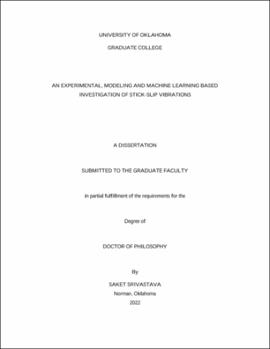| dc.description.abstract | Drilling technologies have improved considerably since the first well drilled by Colonel E.L Drake in 1859. Drilling technologies enable us to safely drill complex well profiles with advanced downhole tools and sensors to reach target zones faster. However, some of the basic inefficiencies in the drilling system have been consistent with time. Drilling vibrations is just one such example. The process of drilling rock involves transfer of energy from the top drive motor to the bit. Naturally, vibrations are inevitable during drilling and cause a reduction in the rate of penetration. While the understanding and mitigation of drilling vibrations has improved, the complexity of drilling conditions has considerably increased as well. The study identifies the different modes of drilling vibrations and presents a comprehensive review of the different methodologies to study and investigate them.
The broad topics included in the study are:
a. Types of drilling vibrations and their effects on drillstring.
b. Mechanisms of failures induced by drilling vibrations and ways to mitigate them.
c. Detailed literature review, specifically gap analysis in cause, detecting and measuring
drilling vibrations with respect to experimental investigation.
d. Overview of drillstring mechanics concept related to drilling vibrations.
e. Review of techniques to mitigate drilling vibrations.
f. Compare and evaluate different data acquisition (sampling rates) concepts for vibration
evaluation with experimental results.
g. Definition and quantification of the stick slip vibrations.
h. Parametric analysis of stick-slip vibrations using experimental test setup.
i. Comparison of experimental and modeling results for examining stick-slip vibrations.
j. Data driven technique to classify vibration severity of stick slip vibrations.
With the above-mentioned different approaches taken to examine drilling vibrations, especially stick-slip vibrations, a deeper understanding of this severe form of torsional vibrations is achieved. With experimental results, it was observed that both drillstring properties (stiffness, inertia) and drilling properties (RPM, WOB, TOB etc.) influenced the severity of stick-slip vibrations downhole. PVC was observed to have the highest stick-slip severity out of different drillstring materials chosen due to its lower torsional stiffness. Additionally, the sampling rate of the measurements significantly impacted diagnostics of stick-slip vibrations. 10 Hz of sampling is the minimum operational sampling rate advised for reliable downhole vibration diagnostics. Moreover, 100 Hz is the ideal sampling rate for complete diagnostics of stick-slip vibrations. The modeling results were in tune with experimental results and provided a fast method to analyze sensitivity of properties such as drillstring stiffness, friction, well angle, bit aggressivity etc. After successfully characterizing stick-slip vibrations using modeling and experimental approach, classifiers were built using machine learning algorithms that were hugely successful in isolating severe downhole vibrations from mild ones. These models were trained on the high-resolution experimental datasets and the issues related to data quality for machine learning applications are also highlighted.
Overall, a comprehensive understanding of severe torsional vibrations has been gained in this study which can be used in the field for better diagnostics, characterization, and mitigation of stick- slip vibrations. | en_US |
